
Flower Garden
Ever dreamed of stepping into your own floral paradise? A flower garden can turn your outdoor space into a vibrant oasis. It’s full of color and life. Whether you’re a seasoned gardener or just starting, creating your dream garden is an exciting journey.
Your flower garden can become a personal masterpiece. It’s a canvas where you can paint with nature’s palette. Let’s explore how to turn your backyard into a breathtaking display.
Ready to dive into the world of petals and perfumes? Get ready to uncover the secrets of crafting a flower garden. It will be the envy of the neighborhood and a sanctuary for your soul.
Creating Your Perfect Flower Garden
Building a stunning flower garden adds joy and color to your yard. Success comes from careful planning and knowing your garden’s needs. Let’s dive into making your flower garden ideas a reality.
Selecting the Ideal Location
Find a spot that gets plenty of sunlight for most flowers to grow well. Make sure it drains well to avoid soggy soil. The right spot can make your garden look great with your home.
Understanding Soil Requirements
Good soil is key for a healthy garden. Test your soil’s pH and nutrient levels. Most flowers like slightly acidic to neutral soil.
Add organic matter to your soil to make it better. This will help your garden grow strong and look great.
Planning Your Garden Layout
Draw out your garden design on paper. Group plants by their needs. Think about height, color, and when they bloom when arranging.
Use eye-catching plants or features as focal points. Don’t forget paths so you can enjoy your garden up close.
By focusing on these key points, you’ll create a beautiful flower garden. It will show off your style and make your yard more beautiful.
Essential Elements of a Secret Garden Design
A secret garden is full of mystery and magic. It’s a hidden spot where nature grows freely. To make your own, include key features that make it special.
Begin with a hidden entrance. A weathered gate covered in vines or an archway with climbing roses is perfect. Winding paths then lead you to discover more of the garden.
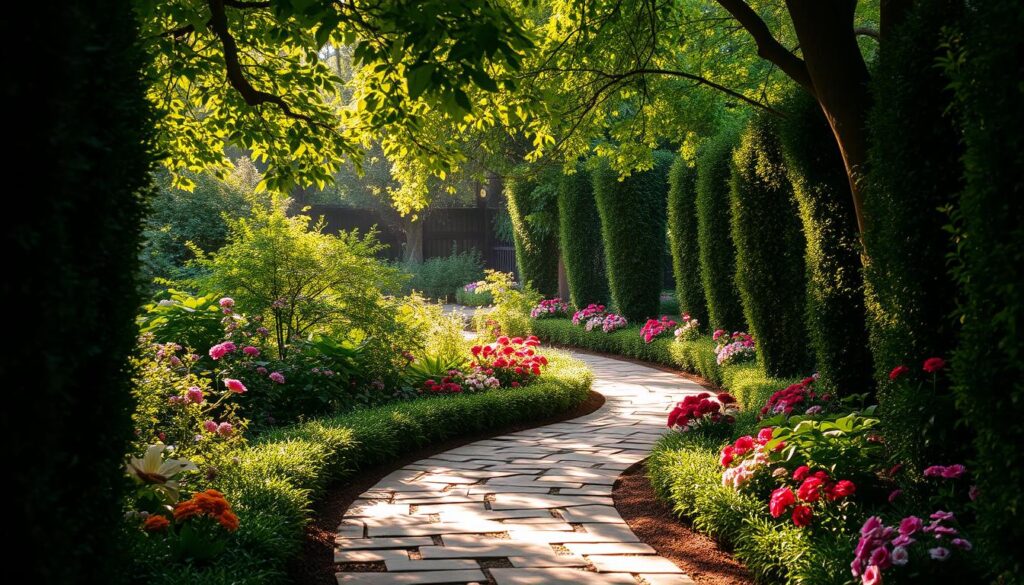
Make sure to include cozy spots for sitting. A bench under a fragrant arbor or a small table in a hidden corner is great. These spots let you enjoy the garden’s beauty up close.
Roses are at the heart of many secret gardens. Pick a variety of climbing, shrub, and rambling roses in soft colors. Plant them everywhere, so their scent fills the air. Add cottage garden plants like foxgloves, delphiniums, and hollyhocks for extra charm.
Water features bring peace to your garden. A small fountain, reflecting pool, or stream is calming. Plant lush greenery around them to make the garden feel even more secluded.
Don’t forget to add a bit of whimsy. An old birdcage with vines, a mossy statue, or a vintage mirror among the plants adds magic. These touches make your secret garden truly enchanting.
Seasonal Blooms for Year-Round Color
A vibrant flower garden brings joy all year. Planning for year-round color ensures beauty always. Let’s look at how to pick blooms for each season, starting with spring.
Spring Flowers Selection
When winter ends, spring flowers bloom with energy. Tulips, daffodils, and hyacinths are great for early spring. Mid-spring brings pansies, primroses, and forget-me-nots.
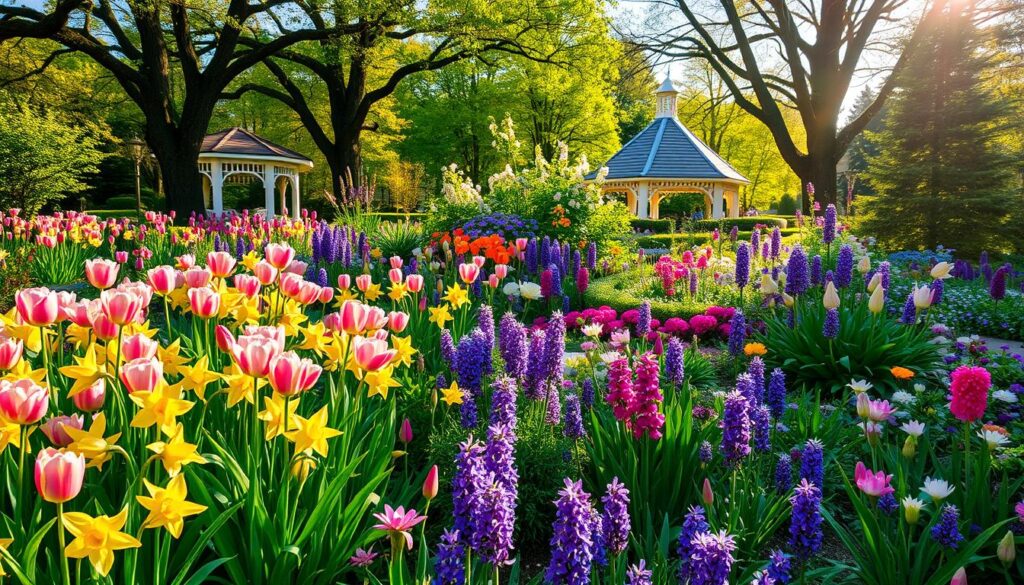
Summer Blooming Varieties
Summer adds a burst of color to your garden. Zinnias, marigolds, and petunias love the sun. Sunflowers or dahlias add drama.
Heat-loving perennials like coneflowers and black-eyed Susans keep your garden lively.
Fall and Winter Garden Planning
Even as it cools, your garden can still dazzle. Chrysanthemums and asters add autumn color. Ornamental kale and pansies handle early frosts.
Evergreens and shrubs with colorful berries add winter interest. Witch hazel or winter jasmine offer blooms in the cold.
Hardy Perennials for Long-Lasting Beauty
Hardy perennials are key to a great flower garden. They come back year after year, bringing beauty with little work. Here are some beautiful options to make your garden vibrant.
Purple Perennials for Color Impact
Purple perennials bring a royal feel to your garden. Lavender’s scent creates a calming vibe. Catmint’s purple flowers cascade, drawing in pollinators.
For a big statement, try delphinium’s tall spikes or asters’ compact clusters.
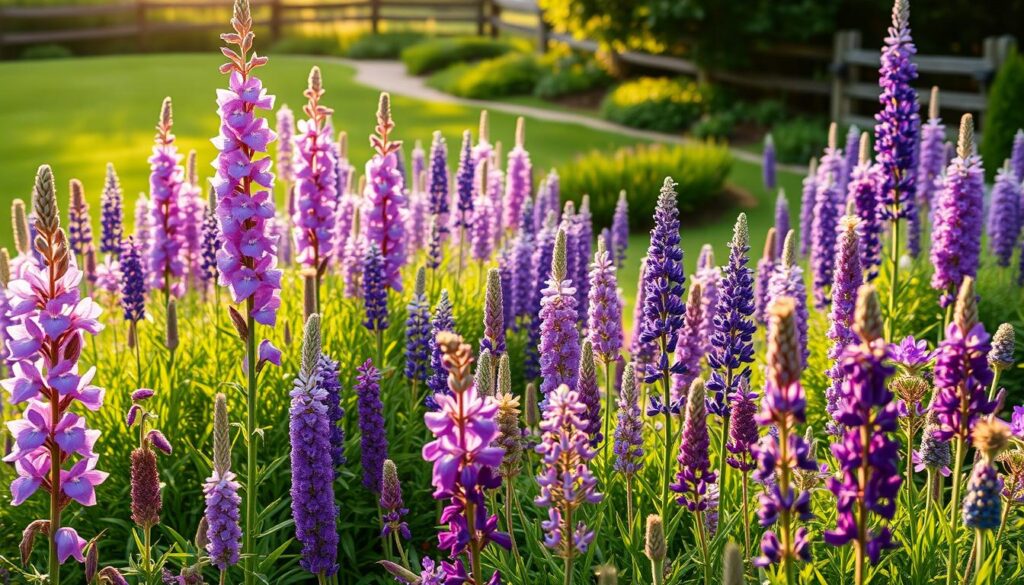
Low-Maintenance Perennial Options
Busy gardeners love low-maintenance perennials. Daylilies grow well in many places and bloom a lot. Hostas provide lush green in shady areas.
Coneflowers are great for attracting butterflies and need little care. These plants thrive with minimal effort.
Combining Different Heights and Textures
Make your garden interesting by mixing heights and textures. Place tall plants like liatris at the back. Use medium-height plants like salvia in the middle.
Put low-growing plants like creeping phlox in front. This layered look adds depth and beauty.
| Height | Purple Perennial | Texture |
|---|---|---|
| Tall | Liatris | Spiky |
| Medium | Salvia | Bushy |
| Low | Creeping Phlox | Mat-forming |
Wildflower Garden Landscaping Tips

Wildflower gardens add natural beauty and help the environment. They support local ecosystems and attract pollinators. With the right planning and care, you’ll see vibrant colors and textures all year.
Start by picking native wildflowers that do well in your area. Native plants need less care because they’re used to the local climate. Clear the land and loosen the soil before planting. Plant seeds in fall or early spring for the best results.
Keeping a wildflower garden is easy. Let the plants grow and produce seeds. Mow once a year in late fall or early spring to keep things in check and encourage new growth.
| Season | Wildflower Garden Tasks |
|---|---|
| Spring | Sow seeds, remove invasive species |
| Summer | Water during dry spells, enjoy blooms |
| Fall | Collect seeds, prepare for winter |
| Winter | Plan next year’s additions, observe winter interest |
Let your wildflower garden be its own unique thing. Watch it grow and change, becoming a home for wildlife and a source of happiness for you. Follow these tips, and your wildflower garden will thrive, making your outdoor space beautiful and good for the planet.
Growing Show-Stopping Dahlias
Dahlias are stunning flowers that add vibrant colors and unique shapes to gardens. They are rewarding for both new and experienced gardeners. These plants come in many sizes, colors, and forms, fitting well into different garden designs.
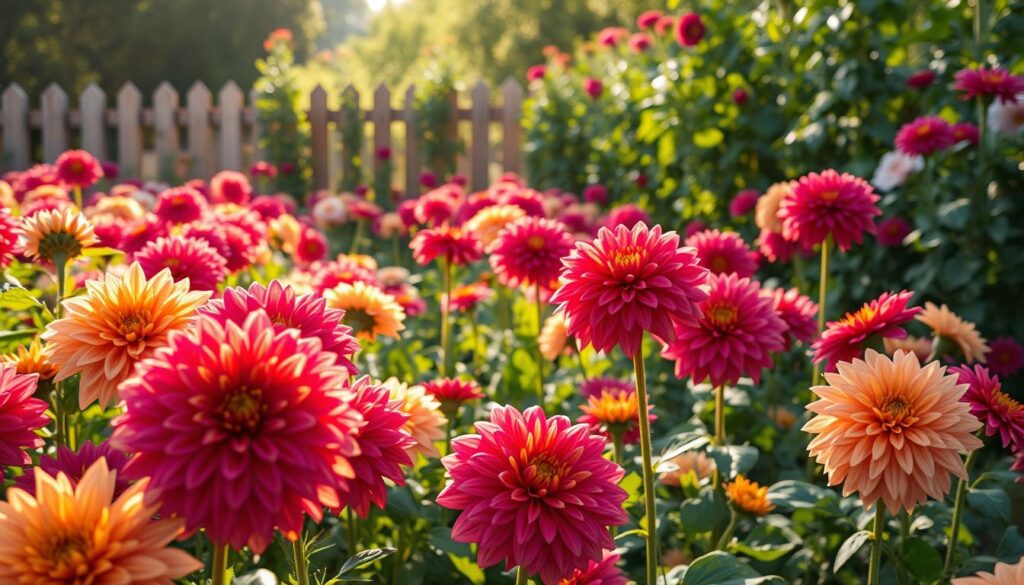
Popular Dahlia Varieties
Dahlia varieties range from small pompons to large dinner plate blooms. There’s a dahlia for everyone. You can find cactus dahlias with spiky petals, decorative dahlias with full shapes, and collarette dahlias with unique collars.
| Dahlia Type | Size | Characteristics |
|---|---|---|
| Cactus | 4-10 inches | Spiky, rolled petals |
| Decorative | 4-12 inches | Flat, overlapping petals |
| Pompon | 1-2 inches | Small, compact blooms |
Dahlia Care and Maintenance
Proper care is key for growing dahlias. Plant tubers in well-draining soil after the last frost. Use stakes to support tall plants. Water deeply once a week and fertilize monthly for lots of blooms. Deadheading regularly helps them bloom all season.
Winter Storage Solutions
In colder areas, dahlias need protection in winter. Cut back the foliage and dig up the tubers after the first frost. Clean them and store in peat moss or vermiculite in a cool, dry place. This keeps them ready for next year’s blooms.
Garden Borders and Edging Ideas
Garden borders add charm and structure to your flower garden. They define spaces, guide the eye, and create visual interest. Let’s explore some captivating ideas for your garden borders that will transform your outdoor space.
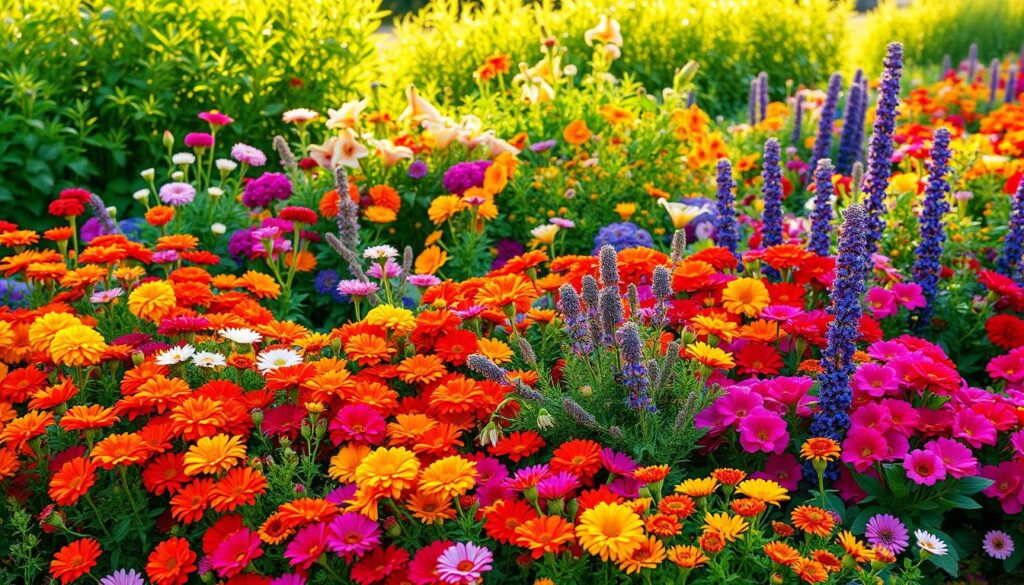
Traditional Border Designs
Classic herbaceous borders never go out of style. These lush, colorful strips feature a mix of perennials and annuals. Arrange taller plants at the back, medium-height ones in the middle, and shorter flowers in front. This creates a tiered effect that’s pleasing to the eye.
Modern Edge Treatments
For a contemporary look, consider sleek metal edging or geometric stone borders. These clean lines provide a striking contrast to soft plantings. Raised beds with built-in seating offer a functional twist on garden borders, perfect for small spaces.
Plant Selection for Borders
Choose plants that complement each other and provide year-round interest. Evergreens offer structure in winter, while flowering perennials bring color in spring and summer. Mix textures and heights for a dynamic border. Don’t forget to include some fragrant plants near walkways for an extra sensory treat.
Remember, well-designed garden borders can elevate your entire garden’s appearance. Experiment with different styles to find what works best in your space. With careful planning, your borders will become a standout feature of your flower garden.
Cut Flower Garden Layout and Planning
Creating a cut flower garden layout brings joy and beauty to your outdoor space. With careful planning, you can enjoy fresh blooms all season long. Start by choosing a sunny spot with well-draining soil for your garden. Sketch out your design, considering factors like plant height, color combinations, and bloom times.
When planning your cut flower garden layout, group tall plants at the back and shorter ones in front. This arrangement ensures all flowers receive adequate sunlight. Leave enough space between plants for air circulation and easy access for harvesting. Consider raised beds or wide rows for better soil management and easier maintenance.
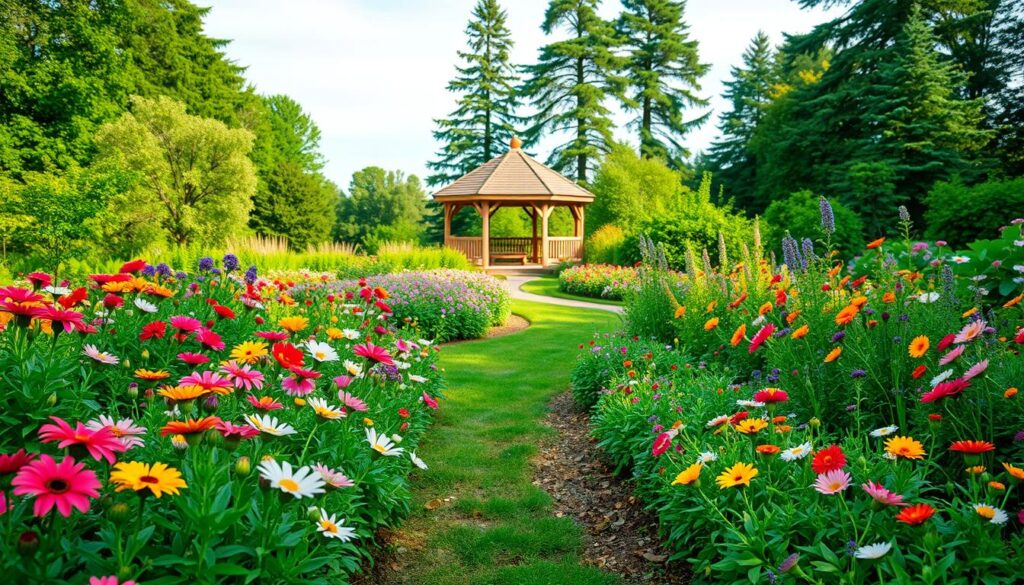
Incorporate a mix of annuals and perennials in your cut flower garden layout. Annuals like zinnias and sunflowers provide quick color, while perennials offer long-term structure. Plan for succession planting by sowing seeds every few weeks. This strategy ensures a continuous supply of fresh-cut flowers throughout the growing season.
Don’t forget to include paths in your cut flower garden layout. These allow easy access for tending and harvesting without compacting the soil. Add support structures like stakes or trellises for tall flowers such as dahlias and delphiniums. With thoughtful planning, your cut flower garden will become a beautiful and productive space.
Container Gardening with Zinnias and Marigolds
Make your outdoor space brighter with zinnias in containers and marigolds. These flowers are great for small gardens, patios, or balconies. Let’s see how to make beautiful container gardens with these colorful blooms.
Best Containers for Flowering Plants
Choose containers that match your zinnias and marigolds. Terracotta pots look classic, while ceramic planters are modern. Make sure your containers have holes for drainage to avoid waterlogging. Pick deeper pots for zinnias to support their roots.
Soil and Fertilizer Requirements
Use a potting mix that drains well for your container gardens. Zinnias and marigolds love nutrient-rich soil. Add a slow-release fertilizer at planting time for healthy growth and lots of blooms.
| Plant | Soil pH | Fertilizer Ratio | Watering Frequency |
|---|---|---|---|
| Zinnias | 5.5 – 7.5 | 5-10-5 | 2-3 times per week |
| Marigolds | 6.0 – 7.0 | 5-10-5 | 1-2 times per week |
Maintenance and Deadheading Tips
Deadheading keeps your zinnias and marigolds blooming. Pinch off spent flowers at the stem base. Water when the top inch of soil is dry. Prune zinnias to make them bushier and flower more.
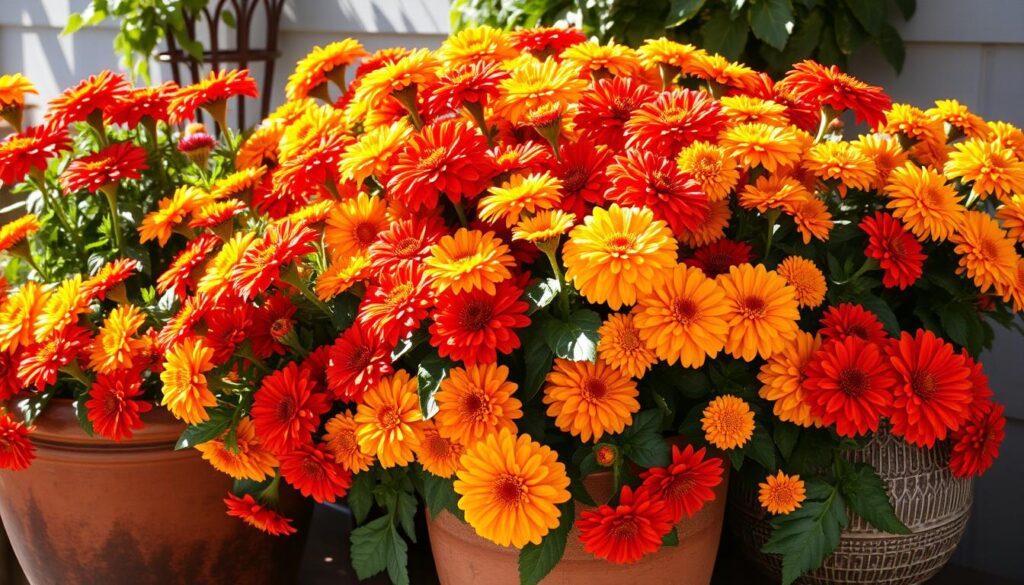
With the right care, your zinnias and marigolds will look amazing all season. Try different varieties and colors to create your dream container garden.
Creating a Chelsea Flower Show Inspired Garden
Want to bring the magic of the Chelsea Flower Show to your backyard? You can create a stunning garden that rivals the best displays at this world-famous event. The key is to focus on eye-catching design elements and clever plant combinations.
Start by choosing a statement plant as your garden’s centerpiece. This could be a striking tree, a large ornamental grass, or a unique sculpture. Next, build layers of color and texture around it using a mix of flowers, shrubs, and foliage plants. Think about how the Chelsea flower gardens use contrast to create visual interest.
Don’t forget the details that make Chelsea flower gardens shine. Add winding paths, water features, or cozy seating areas to create a sense of discovery. Use high-quality materials for your hardscaping to give your garden a polished look. With some planning and creativity, you can craft a garden that captures the essence of Chelsea’s world-class designs.
Leave a Reply